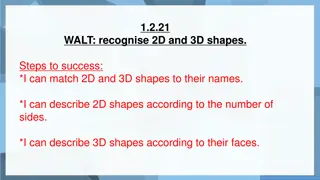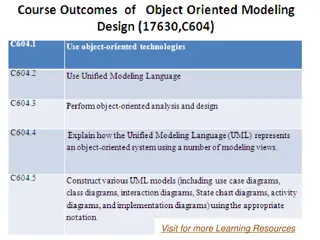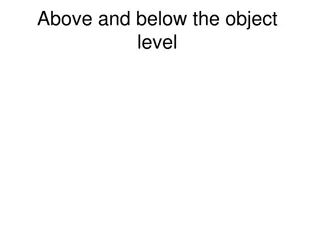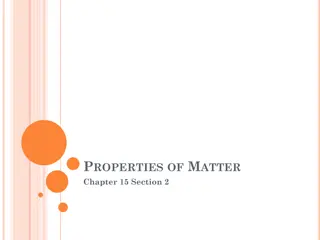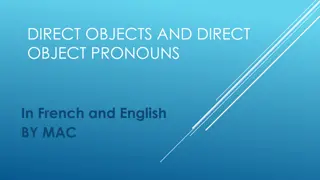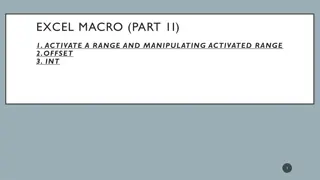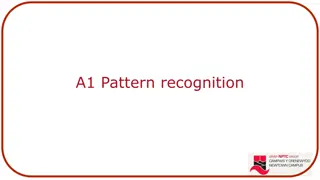Shape Properties for Object Recognition
The importance of studying shape properties for object recognition in image processing. Learn how properties like circularity, elongation, holes, perimeter, and centroid help in distinguishing shapes. Discover how to calculate shape properties using connected components algorithms and MATLAB's regionprops function. Dive into regionprops to retrieve statistics on each region, such as area and centroid. Understand concepts like bounding box, extent, and filled image in the context of shape analysis.
Download Presentation

Please find below an Image/Link to download the presentation.
The content on the website is provided AS IS for your information and personal use only. It may not be sold, licensed, or shared on other websites without obtaining consent from the author.If you encounter any issues during the download, it is possible that the publisher has removed the file from their server.
You are allowed to download the files provided on this website for personal or commercial use, subject to the condition that they are used lawfully. All files are the property of their respective owners.
The content on the website is provided AS IS for your information and personal use only. It may not be sold, licensed, or shared on other websites without obtaining consent from the author.
E N D
Presentation Transcript
Shapes and shape properties Image Recognition Matt Boutell
Why study shape properties? Take a mask of a detected object Consider properties like circularity, elongation, holes, perimeter, and centroid. Many properties are useful to describe shapes (objects detected) to distinguish shapes from each other
How to calculate shape properties? 1. Use a connected components algorithm to isolate individual regions 2. Use MATLAB s regionprops (But we ll build some of our own regionprops in this unit to understand what MATLAB is doing)
Regionprops will return stats on each region. rect = imread('rectangles5.png'); rect(find(rect > 0)) = 255; % to BW [cc,n] = bwlabel(rect,8); % Returns an array of stat structs % 'All' or just those needed allStats = regionprops(cc, 'all'); % returns stats on region 5 only stats = regionprops(cc==5, 'all'); stats.Area 12432 stats.PixelList 12432x2 double stats.PixelIdxList 12432 x 1 double
Some immediately useful properties, part 1: Area and Centroid stats.Area 12432 % num pixels stats.Centroid 756.5123 276.5123 Same as: mean(stats.PixelList) Or: [r,c]=find(cc==5); mean(r), mean(c)
BoundingBox is the smallest axis-aligned rectangle that encloses the region It always touches a pixel on each side of the region. Described by [x,y,width,height] (x,y)_ height width Useful to focus processing on the region. Related idea: Extent is the fraction of the bounding box that the region takes up: ?????? =?????????? ??????
Some immediately useful properties, part 2: FilledImage If holes are too big to fill with dilation: stats.FilledImage fills the holes and returns the bounding box with the filled region. You then need to replace the original bounding box with the filled region. How?
Some immediately useful properties, tangent: imfill Turns out it's easier to use imfill to do this since it doesn't mess with bounding boxes. filledImage = imfill(cc);
Some immediately useful properties, part 3: remove small regions Related: if noise is too big to remove with erosion, you can turn any region with small-enough area to 0, like. stats = regionprops(cc==i, Area ) if (stats.Area < th): cc(cc==5) = 0
Euler number is the number of regions minus the number of holes Useful in character recognition: The letter D has an Euler number of 1-1 = 0 The letter J has an Euler number of 1-0 = 1 The letter B has an Euler number of 1-2 = -1 The letter i has an Euler number of ___. Most letters have an Euler number of ____. This image has an Euler number of ____.
Perimeter and perimeter length aren't the same Perimeter length is a number Perimeter is a set of pixels [r,c]=bwtraceboundary(mask) % Loop and add 1 or 2 for each pair of pixels. bwperim(cc==5) P8(R) R PL8(R), or |P8(R)|, = 6 + 3 2
Perimeter is a set of pixels Perimeter (assuming no holes) is the set of interior border pixels: If we are asked for the "8-connected perimeter", we expect the perimeter pixels to contain diagonals. Definition: ?8(?) = (?,?) ?|?4?,? ? Words: In P8(region), the border pixels are connected with the background using a 4-neighborhood. To get P8in MATLAB, use bwperim(region, 4); The definition for P4is dual to P8. The weird, "pass in 4 to get P8" and vice-versa is only for the bwperim function.
Perimeter length is a number [r,c]=bwtraceboundary(cc==5, & other params) % Gives a list of rows and columns of the boundary: r=[3,4,5,5,5,4,3,3,2,3] c=[2,3,3,4,5,5,5,6,3,2] Then loop. Add 1 or 2 for each pair of pixels: if (r(i), c(i)) and (r(i+1), c(i+1)) are 4-neighbors, add 1 else add 2
Circularity For an ? ? square, C= A circle has maximal area for a given perimeter. So take P/A. Actually ? =4?? For a 10x1 rectangle, C= ?2 For a circle, C= For a C-shape, C= Roundoff is a problem on small shapes, like 3x3 square
Principal axes give the angle and elongation of a region Principal components analysis is a well-known ML technique. 1, elongation: 3.91, angle = -0.0 deg 2, elongation: 3.80, angle = -34.0 deg 3, elongation: 3.80, angle = 54.0 deg 4, elongation: 3.91, angle = -90.0 deg 5, elongation: 3.79, angle = -45.0 deg elongation = stats(2).MajorAxisLength/stats.MinorAxisLength: 3.8016 orientation = stats(2).Orientation: -33.9944
Intuition of PCA Shift and rotate the axes so that one (the principal axis) captures the most variability. How? The axes are the eigenvectors of the covariance matrix, sorted by size of eigenvalues, largest first! Simple for shapes, since only 2D. It works in high dimensions too.
Example: size vs weight for a population of mammals The new axes are more intuitive: The size axis is the principal component: the direction giving greatest variability. size weight girth The girth axis is perpendicular to the size axis. It is uncorrelated and gives the direction of least variability. height
We need to find the covariance matrix, C: ??? ??? ??? ??? ? = ? ???=1 y ? ?=1 (?? ?)(?? ?) ? ???=1 ? ?=1 (?? ?)(?? ?) ? ???=1 ? ?=1 ???= ??? (?? ?)(?? ?) x
We need to find the covariance matrix, C: ??? ??? ??? ??? ? ? ? = ? ???=1 ? ?=1 (?? ?)(?? ?) x ? ? ???=1 ? ?=1 (?? ?)(?? ?) ? ???=1 ? ?=1 ???= ??? (?? ?)(?? ?)
Actual and estimated covariance matrix for various shapes ?1=14,258,160 0 0 924,140 Why should we expect ?1=? 0 0 ?,? ??? ? > ? > 0? ?2=15,211,000 2,098,000 2,098,000 1,392,000 ?3=8,376,490 7,284,670 7,284,670 8,376,490 ?4=924,140 0 0 14,258,160
Can we find the covariance matrix, C, without loops? ??? ??? ??? ??? Put points in a matrix ? = ?1 ?? ?1 ?? ? = ? ???=1 ? ?=1 (?? ?)(?? ?) Subtract off the mean: ?1 ? ? ?1 ? ?? ? ???=1 ? ?=1 (?? ?)(?? ?) ? = ?? ? ? ???=1 Then C= ? ?=1 ???= ??? (?? ?)(?? ?) 1 ????
Theorem The eigenvectors of the covariance matrix give the directions of variation, sorted from the one corresponding to the largest eigenvalue to the one corresponding to the smallest eigenvalue. Because the matrix is symmetric, the eigenvalues are guaranteed to be positive real numbers, and eigenvectors are orthogonal This discussion leads to the Rayleigh quotient ??? ??? ??? ??? ? = Solve ?? = ??
Recap: How to find principal axes and elongation? ??? ??? ??? ??? 1. Calculate spatial covariance matrix, ? = and columns instead of x and y). 2. Find eigenvalues, ?1, ?2, and eigenvectors, ?1, ?2. (use rows 3. The principal axis is the eigenvector corresponding to largest eigenvalue, ????. Direction is the vector, angle from ??? 1if requested. 4. And elongation, the aspect ratio of the shape's length and ???? ???? width along the axes, is for eigenvalues ?.
Lab Could you use the region properties we ve studied to distinguish different shapes (squares, rectangles, circles, ellipses, triangles, )?











